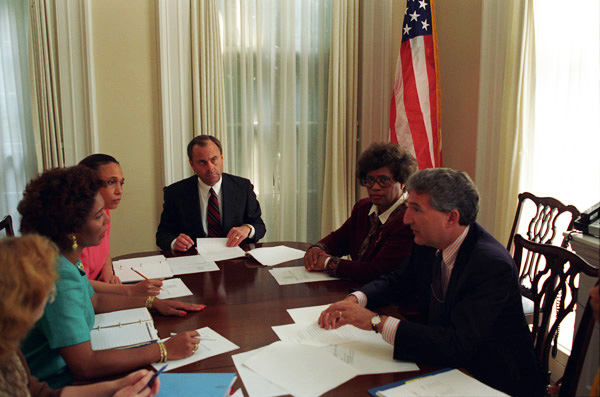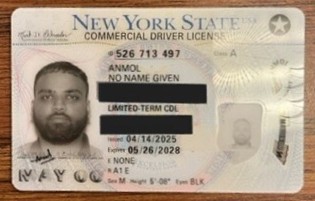Pictured: Chief of Staff Thomas "Mack" McLarty meeting with President William J. Clinton's nominee for Surgeon General, Jocelyn Elders.
Anthrax Death in Oklahoma?
The Oklahoma Constitution filed an open records request for the complete case file for Miller, but we were refused on the grounds that it contained private information protected by statute. We suggested to District Attorney Kuykendall that he may also not have the complete case file. When Kuykendall asked the medical examiner's office for the complete case file, they were told that they did have everything. Expressing concern that Cleveland County could have an unsolved murder, Kuykendall filed the subpoena request with the state attorney general's office to obtain all autopsy reports completed on the late Ron Miller.
The death of a Florida journalist from pulmonary (also called inhaled or airborne) anthrax has focused some renewed interest in the unexplained death of Oklahoma businessman Ron Miller in October 1997. Miller was expected to accuse former Clinton Chief of Staff Thomas F. "Mack" McLarty in the Oklahoma Corporation Commission scandal of the early nineties that sent three individuals to prison.
Nolanda Butler Hill, a former business partner of the late U.S. Commerce Secretary Ron Brown, testified before the Oklahoma Corporation Commission on January 31, 2001. Hill's testimony confirmed the deep involvement of the Clinton White House with the contract between Oklahoma Natural Gas (ONG) and Dynamic Energy Resources of Tulsa. Hill told the Commission that Secretary Brown met with First Lady Hillary Clinton at the White House shortly after Bill Clinton took office in 1993. According to Hill, Mrs. Clinton expressed "appreciation" for Brown's "efforts toward resolution of Mack McLarty's problem in Oklahoma." McLarty's "problem in Oklahoma" concerned "a small gas company, GAGE, with which McLarty had some association."
Brown's role was to iron out a "glitch in the timing" of the sale of GAGE because of a "need for bridge financing to keep the deal from falling apart." Brown told Hill that it was a deal in which McLarty was "involved."
Why was McLarty so concerned about the sale of a relatively small gas supplier in Oklahoma? Why did the first lady take McLarty's "problem" in the matter so seriously? Is Ron Miller, a principal owner of GAGE, dead today because of the need to eliminate him as a threat to the Clinton White House?
It is a complicated story that begins many years ago. Oklahoma Natural Gas, claimed that Creek Systems, a GAGE subsidiary, was "fraudulently" overcharging the company's customers, and sought to end a long-term gas purchase contract with GAGE. Ron Miller took the case to the Oklahoma Corporation Commission, which regulates the natural gas business in Oklahoma. To his dismay, the Commission sided with ONG. This threatened to financially bankrupt Miller and his corporate partner, James H. Kitchens, also of Norman.
On October 2, 1992, Commissioner Bob Anthony made headlines with his public announcement that he had been assisting the FBI (specifically Special Agent John Hippard) in uncovering corruption at the Commission. Anthony cited the GAGE situation as a prime example of a case that was tainted by corruption. Utility lobbyist William Anderson was later convicted of bribing Commissioner Bob Hopkins in a case involving Southwestern Bell Telephone. Anderson was a lobbyist not only for Southwestern Bell, but also for ONG and Arkansas Louisiana Gas (ARKLA). Commissioner Anthony received covert payments from ARKLA senior executives at the same time that ARKLA had multimillion dollar rate cases before the commission. At the time, Thomas McLarty, a childhood friend of Bill Clinton, was the Chief Executive Officer of ARKLA. Another childhood friend of Clinton's and McLarty's, Vince Foster, handled ARKLA business at the Rose Law firm while a partner with Hillary Clinton. As Anthony explained, "Even if Mack McLarty did not personally participate in or did not personally know of the illegal conduct of his senior officers, it certainly would have been a skeleton in his closet."
Miller struck back by suing Anderson and "those who directed the conduct of Mr. Anderson." He planned to show a pattern of corruption at the Commission, including evidence of illegal activities of utility companies other than ONG. McLarty was clearly exposed to, at a minimum, severe embarrassment.
Miller's associate, Jim Kitchens, had some business associates in California, that suddenly entered the picture. Nora and Gene Lum were Democratic Party fund-raisers with close ties to Commerce Secretary Ron Brown. With Brown's help, they created Dynamic Energy Resources. The Lums had no prior experience in the oil and gas business and virtually no assets. They sought out Tulsa oil man Stuart Price. Price had strong connections to the Democratic Party establishment through his wife, who is a niece of former Senate Majority Leader George Mitchell. The Lums gave Michael Brown, son of Ron Brown, a five percent share in the company and a seat on the board. Another board member, Helen Yee, had a daughter (Melinda Yee) who was a personal assistant to Ron Brown. The Lum's daughter, Trisha, worked for Ron Brown at the Commerce Department.
ONG negotiated a deal to pay above market prices to Dynamic Energy Resources in a contract that would make Dynamic one of ONG's major suppliers of gas. Dynamic would get their gas to sell to ONG from GAGE, once the purchase was made. ONG defended what some saw as a very sweet deal for Dynamic this way: "In the company's view, the new gas purchase contract with Dynamic and a separate global settlement of all the outstanding legal issues (in which no money was paid to any of the parties), was in the best interest of its ratepayers."
John Tisdale represented Dynamic in the negotiations. Tisdale was a law partner with Clinton confidant Bruce Lindsay, and handled legal matters for Bill Clinton in Arkansas. During negotiations, Tisdale received faxes and phone calls from the White House. As Nolanda Hill told the Corporation Commission, the deal was in danger of falling apart without "bridge financing." On the afternoon of November 9, 1993, one day before the Miller lawsuit was set for trial before the Oklahoma Supreme Court, a wire transfer of four and a half million dollars was credited to Dynamic Energy Resources at a Walton-owned bank in Tulsa. Hillary Clinton had served on the board of directors of Wal-Mart and was good friends with Alice Walton (daughter of the late Sam Walton). Alice Walton owned Llama Capital Corporation in Arkansas, which is believed to have provided the loan.
In approximately contemporaneous events on November 9, 1993, Dynamic Energy Resources formally acquired the assets of GAGE Corporation and its subsidiary (Creek Systems) and dropped the GAGE lawsuit against William Anderson. When visited at an Oklahoma City nursing home by the Oklahoma Constitution, Anderson refused to talk about his activities that sent him to prison, but he did express high regard for Mack McLarty as a "very capable man."
The Lums were deeply involved in illegal fund-raising for the Democratic Party before and after the formation of Dynamic. In September of 1997, the Lums were convicted and spent a short time in prison. Some charge that the Clinton Justice Department settled their case early to prevent more damaging revelations. Hillary Clinton's former Rose Law firm partner, Webster Hubbell, was charged by congressional investigators of shutting down further investigations in his role as the number three man at the Justice Department.
Nora Lum is recorded as having visited the White House at least 18 times during Clinton's first term. The Lums were associates of John Huang, who also pleaded guilty to campaign finance violations. The Lums and Huang were also associated with Indonesian businessman James Riady, a member of the family that runs the global conglomerate, the Lippo Group. The Riady family were financial supporters of Clinton's gubernatorial and presidential campaigns.
According to Michael McAdams, a GAGE vice president, who was hired on as a consultant for Dynamic, Ron Brown and the White House were deeply involved in the Dynamic deal. "It was confirmed verbally from the first time I met the Lums by the Lums, and Stuart Price, that Nora worked directly for Ron Brown." McAdams recalls phone calls from the White House, from personalities like Clinton aide George Stephanopolous.
As the criminal investigations into Brown's activities moved closer, Brown signaled an interest in making a deal with prosecutors. Brown died in a plane crash while on a trade mission in the Balkans on April 3, 1996. The Air Force jet which carried Brown went down with 33 others. It was the number two plane in the presidential fleet, having flown Hillary Clinton and her daughter Chelsea one week earlier on an overseas trip. Brown's sudden death aborted an independent counsel's investigation into Brown's role in the Dynamic Energy deal.
After the sale of GAGE, Ron Miller aided news reporters and government authorities in the investigation of the Lums. Miller made 165 tape recordings of his conversations with the Lums and their associates. Miller worked closely with FBI agent John Hippard, who had also worked with Anthony, during this time. Stuart Price reportedly heard Gene Lum telling another unidentified person that if another unidentified someone is giving too much trouble, "just have him killed." When we contacted Price to elaborate on this incident and related issues, he informed us that he was getting ready to eat dinner (it was nine-thirty at night) and that he would call us back. He never did.
Miller turned over the tapes to Hippard of the FBI in early August of 1997, and was interviewed by congressional committee staff a few days later. The committee subpoenaed documents from Miller concerning Brown, the Lums, and Dynamic.
On September 5, 1997, the congressional committee deposed McLarty. He was asked about ARKLA lobbyist Bill Anderson, but McLarty's lawyers diverted questioning. The congressional committee was scheduled to begin its formal proceedings on October 8, with Ron Miller slated to testify.
Miller received a large sum up-front at the time of the GAGE-Dynamic sale in 1993, with installments scheduled over the next few years. After a couple of years, payments in the deal brokered by a Lums associate Don Sweatman, ceased. Despite Miller's pleading and demanding, no more money was forthcoming, driving Miller toward bankruptcy. One time Miller was told by Sweatman not to worry, because, "Hillary said you'll get your money."
After Miller refused what his lawyer considered an inadequate settlement in January 1997, Sweatman told Miller, "You haven't been shot at yet." According to a police report filed by Miller following this event, "the subjects he is dealing with have made number of references to certain people wanting Mr. Miller dead."
Miller received several death threats after he vowed to pursue those who directed the activities of Bill Anderson. One business partner told us that Miller was once "almost run off the road."
Another time, Miller was followed after meeting with FBI agent John Hippard in Oklahoma City, all the way back to Norman.(This was independently confirmed by Miller friend Mike McCarville, a radio talk show host for KTOK Radio in Oklahoma City). He received threatening phone calls, such as one telling him to "Back off M----- F-----." The next morning, the person called back and said, "Don't forget what I said."
Prowlers were reported at Miller's house, with attempts to tamper with his cars (Miller did not have a garage). The most bizarre effort at intimidation came from a helicopter hovering outside his office off of State Highway #9 in Norman. Miller told a TV reporter that he was told by friends in the intelligence community that the helicopter was leased to the government for use in the 1996 Atlanta Olympics. Miller told one reporter that the helicopter was so close to his window, that he could have "reached out and touched it." Miller went to retrieve a handgun and when he returned the helicopter flew away. Several individuals, including the manager at the hotel across the street, saw the helicopter hovering outside Miller's office window. When we contacted former FBI agent Hippard at the law office where he now works, he deferred comment on this incident. A private investigator hired by Miller was the victim of a similar incident with a helicopter at his home a few weeks later. (For more detail on these incidents, read "Oklahoma Natural Gas Overcharges Tied to Clinton White House," in our spring 2001 issue.)
Preparing to testify before Congress in a few days, Miller told a business associate that his testimony would insure that Al Gore would never become president. According to Miller's calendar, Hippard installed a "sound system" in Miller's office on Wednesday, October 1, 1997. The next day, Miller was scheduled to meet again with Don Sweatman in the afternoon of Thursday, October 2, 1997. The Oklahoma Constitution was unable to contact Sweatman for his recollection of the last days of Ron Miller. Earlier in the day, Miller became increasingly ill with what he believed to be the flu and apparently canceled the meeting.
Miller did not go to work the next day (Friday) and his condition worsened on Saturday to the point that he was taken to the emergency room at Norman Regional Hospital. Doctors diagnosed pneumonia and he was admitted to the hospital. Miller was treated with antibiotic drugs and his condition improved over Sunday, Monday and Tuesday. By Tuesday, he was off the respirator and his temperature was normal.
Early Wednesday morning, Miller was in respiratory distress, with a temperature spiking to 105. Miller was transferred to Baptist Hospital, where doctors worked to determine the cause of his pneumonia. His condition only worsened and he died on Sunday, October 12. (For more on this specific aspect of the story, see our summer 2001 issue and the story, "The Strange Death of Ron Miller.") The case was referred to the Oklahoma Chief Medical Examiner (CME). After five months (investigations typically take six weeks to complete) the CME finally called Miller's death a result of "acute respiratory distress syndrome," or a type of pneumonia of undetermined etiology (cause). While the CME could not determine the cause of death, they chose to list his death as of "natural causes."
That determination was challenged by an investigator, Dr. Stephen Dresch of Michigan, who was working a case involving the Ron Brown plane crash. After reading Dresch's reasoning, Dr. Fred Jordan, Oklahoma's long-time chief medical examiner, changed the cause of death to "undetermined."
After consulting several medical experts and sources, we asked the CME office about the possibility of inhaled anthrax. Ray Blakeney, the chief spokesman for the office, discounted that possibility, "unless it had taken a course that did not allow us to detect that." When we filed an open records request to obtain the entire case file, so we could review specific lab work rather than summaries we were provided, Blakeney denied our request, citing statutory privacy concerns. The summaries of the report mention that the office tested for Ricin poisoning, but no mention was made of a test for anthrax. Hospital records indicate that testing was done for lung cancer, tuberculosis and legionnaire's pneumonia. All were negative. The summary does not mention any tests conducted for anthrax. One physician who reviewed the medical records and the summary from the CME told us, "It is my opinion that they most likely did no test for inhaled anthrax."
While Miller was treated with antibiotics of various sorts at both Norman and Baptist hospitals, Cecil's Textbook of Medicine states that, "(T)he progressive course may be so rapid that antimicrobial drugs may not save the patient's life." This is because the bacteria can be eradicated, but the anthrax toxin continues unopposed until the patient's death.
Some important signs of pulmonary anthrax include a widened mediastinum and acute tubular necrosis, both of which Miller had. Other symptoms common to inhaled anthrax suffered by Miller include fever, chills, hypotension, diasphoresis, shock, non-productive cough, severe breathing problems, and confusion. Bacillus anthracis is a large, gram-positive bacteria. Medical records indicate that Miller's lab test confirmed gram-positive bacteria.
Shortly before we went to press, Jerry Bohnen of KTOK Radio in Oklahoma City, who had done several stories about the Miller-Gage-Dyamic Energy affair in the mid-nineties, interviewed a former Arkansas state trooper, Russell Welch, who survived inhaled anthrax. The trooper was investigating the MENA drug ring in Arkansas in 1991 when he became ill. The first doctor that he sought help from could not determine the cause of his illness. A second physician was an Army Reserve doctor who served in the Gulf War, and had received special training in detecting airborne anthrax. He was able to begin treatment early and, after fourteen days in the hospital, survived. Welch told Bohnen that he believes he was infected "through the mail."
The District Attorney in Cleveland County, Tim Kuykendall, opened an investigation following the change in Miller's case from a natural death to undetermined. When his office asked the FBI for material from their investigation, they assured the DA's office that no investigation was necessary because they had done an "exhaustive investigation." Officials with the Norman Police Department were told that "the feds had investigated," and found nothing, according to a Norman police officer who asked to remain anonymous. We submitted a freedom of information request to the FBI in August of this year, asking for all material involved in their investigation into the death of Ron Miller. The FBI responded in a letter dated September 18th. According to the letter, signed by Carl Benoit, the chief division counsel, Miller's death was never of "investigatory interest to the FBI." We later talked with Benoit, who encouraged us to submit our request again.
Before resubmitting the request, we contacted John Hippard, the FBI agent (now retired) who worked closely with Miller for five years. Hippard said that, in his dealings with Miller, Miller had never given him any reason to doubt his word, or trustworthiness. We asked Hippard for guidance in how to word a resubmission, and referenced Benoit. Hippard said at first that he was not familiar with Benoit, but then later said, "Oh yeah, he is the legal advisor. He came on after I left." A few weeks earlier, Hippard and Benoit were in a meeting together at Oklahoma City FBI headquarters discussing the Miller tapes with Edward Clarke of the Walker and Walker law firm. (The tapes are at issue in a related possible civil litigation.) When we asked whether the bureau ever did an investigation into Miller's death, Hippard said that he would have to defer to whatever Benoit told us in the letter.
We plan to resubmit our freedom of information request and report the bureau's response in our next issue.
Hippard is now working as an investigator for Patrick Ryan, who is now an Oklahoma City attorney. Ryan formerly served as U.S. Attorney in the mid-nineties, appointed by President Clinton. Ironically, Ryan served as a defense attorney for a utility executive who took the fifth amendment during the Corporation Commission scandal, while Hippard was a top agent in the investigation of corruption at the Commission. Hippard later was a key FBI figure in the investigation of the Murrah bombing at the time Ryan was U.S. Attorney and Ryan was apparently impressed with Hippard's abilities. Associates of the late Ron Miller have all told us that Miller "trusted Hippard implicitly." Commissioner Bob Anthony, who worked with Hippard during the Corporation Commission scandal, has also expressed a high regard for Hippard. We would like Hippard to talk to us about several aspects of the Miller affair but he said he could not comment legally on certain aspects of the case.
Hippard assured us that he felt no pressure from the Clinton Administration to not pursue any criminal activity in the case.
We have read hundreds of pages of material and interviewed scores of individuals in preparation for these articles. Several individuals have spoken to us only on condition of anonymity. Others have flatly refused to discuss the matter with us at all. More than one person specifically expressed concern about Mack McLarty and others closely connected to the Clintons. One person, when told what we were calling about, exclaimed, "Oh my God!"
Several individuals have aided us in these reports, persons with diverse areas of expertise. As we prepared to go to press, we are planning to resubmit our freedom of information request to the FBI and we are pursuing leads that we hope to report in our next issue. One person with the CME's office in Oklahoma City has said that they may refer the case to the Center for Disease Control (CDC). Blood and tissue samples retained by the CME's office may also be referred to an independent pathologist for a second opinion. We ask any of our readers who may have information to help us uncover the final truth on the death of Ron Miller, to E-mail us at okconsti@aol.com or investigator Dr. Stephen Dresch at sdresch@forensic-intelligence.org.












Latest Commentary
Thursday 30th of October 2025
Thursday 30th of October 2025
Thursday 30th of October 2025
Thursday 30th of October 2025
Thursday 30th of October 2025
Thursday 30th of October 2025
Thursday 30th of October 2025
Thursday 30th of October 2025
Thursday 30th of October 2025